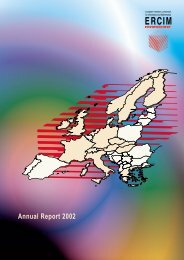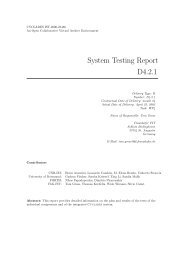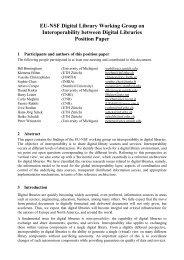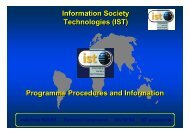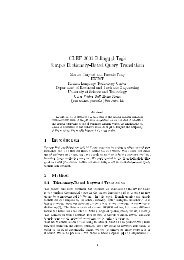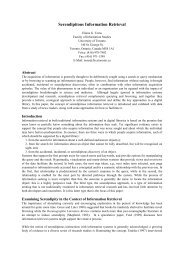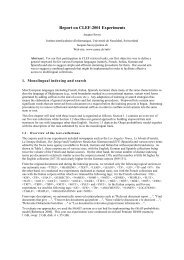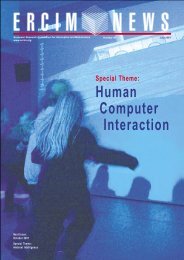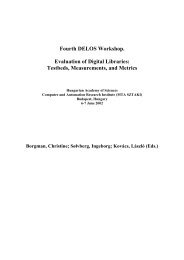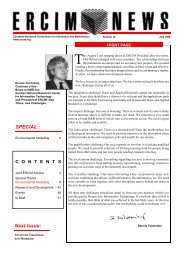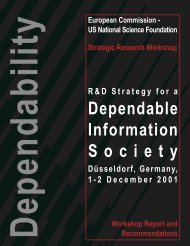Towards a Platform for Widespread Embedded Intelligence - ERCIM
Towards a Platform for Widespread Embedded Intelligence - ERCIM
Towards a Platform for Widespread Embedded Intelligence - ERCIM
You also want an ePaper? Increase the reach of your titles
YUMPU automatically turns print PDFs into web optimized ePapers that Google loves.
R&D AND TECHNOLOGY TRANSFER<br />
Electromagnetic Radiation<br />
Cell Phone Danger<br />
by Martin Röösli and Harry Rudin<br />
As we become more and more keen on cell phones there remains the open<br />
question of what effect these cell phones have on our health and well being. Some<br />
recent work in Switzerland sheds some light on these issues.<br />
Our dependence on and investment in<br />
cell phones rise steadily. The annual sale<br />
of cell phones is approaching 1 billion<br />
units. Is the result of all the accompanying<br />
electromagnetic radiation going to<br />
have an effect on our health? Almost<br />
everyone has heard some 'anecdotal evidence'<br />
where there have been some<br />
undesirable effects on people: headache,<br />
concentration problems, irritability,<br />
insomnia, etc. But, can anything be said<br />
on a scientific basis? Some recent<br />
research from Switzerland has shed<br />
some light on the subject. More light is<br />
needed and some is coming.<br />
The topic is difficult in itself and made<br />
more difficult by the enormous financial<br />
interests involved. Ideally, in a cold, scientific<br />
experiment, one should find a<br />
group of humans, some of whom would<br />
be subjected to the electromagnetic radiation<br />
produced by cell phones and their<br />
base stations <strong>for</strong> several years and some<br />
of whom in the group would not be<br />
exposed. All of them would be blind to<br />
exposure and they would not differ in<br />
terms of other factors influencing their<br />
58 <strong>ERCIM</strong> News No. 67, October 2006<br />
health. One could carefully measure<br />
their health status and their well being,<br />
distinguishing between those exposed<br />
and those not exposed. Obviously this<br />
has not been done nor will it be done in<br />
the future.<br />
While much material has been published<br />
with the objective of shedding light on<br />
the problem, many of the published<br />
studies have serious methodological limitations<br />
- leading to doubts concerning<br />
What effect have<br />
cell phones on<br />
our health and<br />
well being?<br />
their validity. Reference [1] summarizes<br />
studies on mobile phone radiation and<br />
health-related quality of life, concluding,<br />
"The results are contradictory and the<br />
greater part of these studies is not able to<br />
address the issue of causality between<br />
exposure and outcome."<br />
One of the first studies dealing with<br />
radio frequency electromagnetic field<br />
exposure was about the shutdown of the<br />
Swiss Schwarzenburg short-wave radio<br />
transmitter. While this took place back in<br />
1998, a recently published paper [2]<br />
reports of measurements in the change in<br />
the melatonin produced by 54 volunteers<br />
living in the vicinity. The measurements<br />
showed that in the week after the shutdown,<br />
sleep quality improved and melatonin<br />
excretion increased by 15 percent,<br />
on average. (Melatonin plays an important<br />
role in regulating sleep-wake cycles<br />
because its production is inhibited by<br />
light and permitted by darkness.<br />
Melatonin is sometimes prescribed when<br />
suffering from jetlag.) However, the shut<br />
down date was known to the study participants.<br />
Thus, the authors state that<br />
"blinding of exposure was not possible<br />
in this observational study and this may<br />
have affected the outcome measurements<br />
in a direct or indirect (psychological)<br />
way."<br />
In September, 2003, the Dutch TNO<br />
Physics and Electronic Laboratory<br />
announced the results of a study. They<br />
wrote: "The present study contributes to<br />
the research on finding a relation<br />
between electromagnetic fields and brain<br />
functions." Further, "Exposure to GSM-<br />
900 or GSM-1800 electromagnetic fields<br />
had no effect on well-being in either<br />
experimental group. However, exposure<br />
to a UMTS-like signal resulted in a<br />
small, but statistically significant impairment<br />
of well-being. Interestingly this<br />
effect was not only observed in individuals<br />
with self-reported health complaints<br />
attributed to daily life EMF exposures<br />
but also in a reference group without<br />
such complaints. This effect was found<br />
after only about half an hour's exposure<br />
to what, by everyday standards, was a<br />
relatively high environmental field<br />
strength (1 V/m). In practice, while individuals<br />
in the vicinity of operational<br />
UMTS antennas will be subject to continuous<br />
exposure, the field strengths in<br />
question will be lower." Thus, the transferability<br />
of the 'TNO'-results to normal<br />
day-to-day environmental exposure is<br />
questionable. [3]<br />
There was considerable criticism of the<br />
circumstances of this study including<br />
that by its authors themselves. These<br />
authors and others recognized the need<br />
to make a more careful repeat of the



